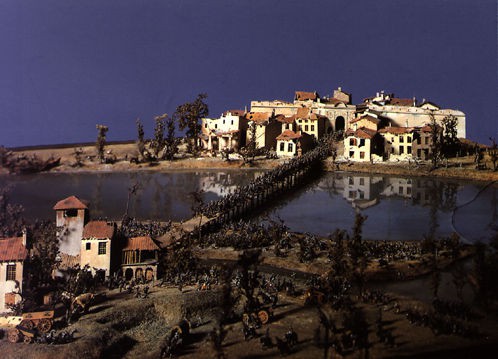Lodi is a small Lombard city situated southeast of Milan. On 10 May, 1796, in the course of the first Italian campaign, Lodi was the scene of a violent battle. Bonaparte, after having crossed the Po near Piacenza, pushed to trap the Austrian army of General Beaulieu west of the Adda. Beaulieu fell back, the French collided with his rear guard led by Sebottendorf. The bitterest fighting took place around Lodi bridge. While the French troops commanded by Beaumont and Ordener were crossing the river above the city, Massena succeeded in crossing the bridge thereby blocking an Austrian retreat to Mantua. The victory at Lodi, which gave Bonaparte his nickname the “Little Corporal”, opened the route to Milan and assured him his conquest of Lombardy. On 11 May, 1796, he wrote to Carnot, “La bataille de Lodi donne à la République toute l'Italie” (The battle of Lodi has given the Republic all of Italy).
Today, Lodi bridge is situated at the northern end of Corso Adda in the city. It sits a little south of where the original bridge was in 1796. Across from it, on the side of the old city, a house has a commemorative plaque in Italian, which translated into English says: On 10 May, 1796 / Napoleon Bonaparte / shaking off the yoke of two centuries / here / launched his invincible columns / against Beaulieu's corps / and routed him. / Here / on 10 May, 1859, / Lodi, exulting in its liberation / through the storm of flames / that enveloped this historic bridge, / saw the swift disappearance of the last phalanx of the Austrian army. The Museo Civico (63, corso Umberto I) is installed in an old convent of the 13th-century and presents in certain of its rooms souvenirs of the battle as well as fragments of a commemorative monument built in 1809 but later destroyed by the Austrians. Other buildings in the city evoke the passage of Bonaparte: the church of Magdalene whose steeple served as a watch-tower during the battle; Palazzo Pitoletti that Bonaparte made into the officers headquarters on the evening of the victory; and Palazzo Sommariva where the count François Melzi d'Eril, chief of the Milanese delegation, brought him the keys of the city of Milan on 11 May, 1796.


